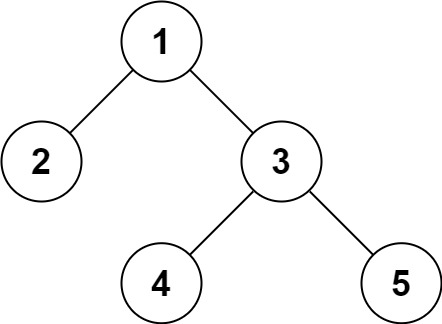Problem
Serialization is the process of converting a data structure or object into a sequence of bits so that it can be stored in a file or memory buffer, or transmitted across a network connection link to be reconstructed later in the same or another computer environment.
Design an algorithm to serialize and deserialize a binary tree. There is no restriction on how your serialization/deserialization algorithm should work. You just need to ensure that a binary tree can be serialized to a string and this string can be deserialized to the original tree structure.
Clarification: The input/output format is the same as how LeetCode serializes a binary tree. You do not necessarily need to follow this format, so please be creative and come up with different approaches yourself.
Example 1:

Input: root = [1,2,3,null,null,4,5]
Output: [1,2,3,null,null,4,5]
Example 2:
Input: root = []
Output: []
Constraints:
The number of nodes in the tree is in the range
[0, 10^4].-1000 <= Node.val <= 1000
Solution (Java)
/**
* Definition for a binary tree node.
* public class TreeNode {
* int val;
* TreeNode left;
* TreeNode right;
* TreeNode(int x) { val = x; }
* }
*/
public class Codec {
private static final int BASE_OFFSET = 1000;
private static final String DELIM = "*";
private int offset;
// Encodes a tree to a single string.
public String serialize(TreeNode root) {
StringBuilder sb = new StringBuilder();
offset = 0;
serialize(root, sb);
return sb.toString();
}
public void serialize(TreeNode root, StringBuilder sb) {
// all nodes fit into 4 bits.
// IFF we offset at 0. So encode(val) = val + min(default - 1000)
if (root == null) {
sb.append(DELIM);
return;
}
String s = Integer.toHexString(root.val + BASE_OFFSET);
StringBuilder sb2 = new StringBuilder();
for (int i = 0; i < 3 - s.length(); i++) {
sb2.append('0');
}
sb2.append(s);
sb.append(sb2);
serialize(root.left, sb);
serialize(root.right, sb);
}
// Decodes your encoded data to tree.
public TreeNode deserialize(String data) {
if (data.charAt(offset) == '*') {
offset++;
return null;
}
TreeNode root =
new TreeNode(
Integer.parseInt(data.substring(offset, offset + 3), 16) - BASE_OFFSET);
offset += 3;
root.left = deserialize(data);
root.right = deserialize(data);
return root;
}
}
// Your Codec object will be instantiated and called as such:
// Codec ser = new Codec();
// Codec deser = new Codec();
// TreeNode ans = deser.deserialize(ser.serialize(root));
Solution (Javascript)
function TreeNode(val) {
this.val = val
this.left = null
this.right = null
}
const serialize = (root) => {
let current = [root]
const result = []
while (current.length) {
const next = []
current.forEach((node) => {
result.push(node ? node.val : null)
if (node) {
next.push(node.left, node.right)
}
})
current = next
}
return JSON.stringify(result)
}
/**
* Decodes your encoded data to tree.
*
* @param {string} data
* @return {TreeNode}
*/
const deserialize = (data = '') => {
const list = JSON.parse(data)
if (list.length === 0 || list[0] === null) {
return null
}
const root = new TreeNode(list.shift())
let current = [root]
while (current.length > 0) {
const next = []
current.forEach((node) => {
if (node !== null) {
const leftValue = list.shift()
const rightValue = list.shift()
node.left = leftValue == null ? null : new TreeNode(leftValue)
node.right = rightValue == null ? null : new TreeNode(rightValue)
next.push(node.left, node.right)
}
})
current = next
}
return root
}
Explain:
nope.
Complexity:
- Time complexity : O(n).
- Space complexity : O(n).